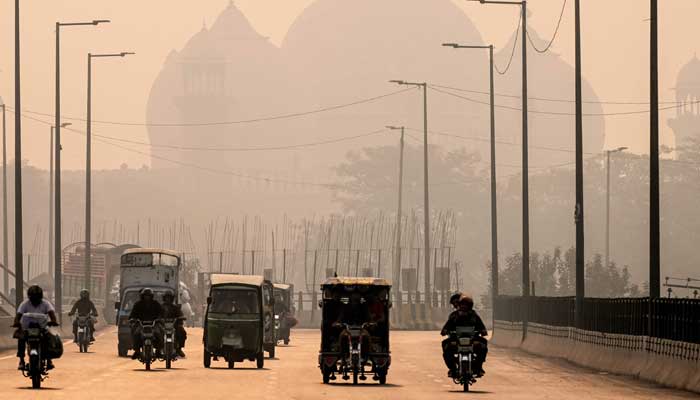Paish E Nazar – پیشِ نَظر
Columns by Hassaan Ahmad Awan

Urban Air Pollution Crisis: Lahore Tops Global AQI Charts Again
Long‑form look at lifestyle changes and health consequences in extremely polluted zones
by Hassaan Ahmad Awan
Lahore has once again made headlines—not for traffic or festivals—but for having one of the world’s worst Air Quality Index (AQI) readings in early 2025. With AQI levels soaring past 400 on multiple consecutive days, the city has become a global example of urban smog crises. This alarming data should trigger reflection—not resignation—about how citizens can adapt lifestyles and authorities can mitigate health risks in zones of persistent high pollution.
Smog City: Lahore’s Air Quality Nightmare
Recent reports show Lahore’s AQI surpassed the “hazardous” threshold several times in January and February 2025. This placed it among cities like Delhi, Beijing, and Karachi in peak smog situations. Headlines blared: “Lahore breathes death”. Schools were closed; public health warnings repeatedly flagged short-term exposure as potentially lethal, especially for children, the elderly, and those with respiratory issues.
Health Repercussions: What Prolonged Exposure Means
Science has long warned: chronic exposure to PM₂.₅ and PM₁₀ particles increases risk of asthma, COPD, heart disease, and even lung cancer. Studies show that daily exposure above 250 AQI can lead to:
-
Increased emergency room visits
-
Reduced lung function in children
-
Exacerbation of cardiovascular conditions
-
Mental health effects like anxiety and depression
In Lahore, hospitals report a 25% increase in respiratory distress cases. Asthma inhalers are sold out at pharmacies; surgical masks and air purifiers are suddenly high-demand consumer goods.
Lifestyle Adaptations: Coping with the Smog
One Reddit thread titled “Living in Lahore Right Now” brought forth dozens of everyday adaptations:
-
Indoor Air Quality (IAQ): People now keep air purifiers running 24/7 and seal windows with adhesive strips.
-
Activity Shifts: Joggers move their workouts indoors or to late-night hours when AQI dips. Children are kept indoors during “smog peaks.”
-
Mask Upgrades: N95 masks are no longer a fashion accessory but a necessity for anyone commuting outdoors.
-
Diet Changes: Residents report adding antioxidants, vitamin C-rich foods, and lung-cleansing teas like tulsi and ginger into daily diets.
Yet the emotional toll is high: one mother noted, “My 8-year-old asks why city lights seem dim at noon—and I have no answer.”
Workplaces and Education: Seeking Safe Zones
Offices are turning boardrooms into air-quality controlled zones, while schools shift to online classes during high-PM days. Universities survey plans to build indoor recreation centers with filtered air for students. Shopping malls and public spaces advertise “clean air lounges,” though cost makes them accessible only to the urban middle class.
Government Measures: Panic or Policy?
Authorities introduced temporary bans on brick kilns, short-term “car-free” days, and leaf-blower restrictions. But these feel reactive. Air pollution monitors are often offline for maintenance. Public messaging shifts between vague exhortations and alarming warnings, creating public confusion rather than constructive action.
Some progressive cities have begun offering subsidies for home air purifiers and incentives for EV (Electric Vehicle) adoption, but implementation remains inconsistent.
Global Lessons, Local Realities
Cities like Beijing and Los Angeles have moved from emergency smog plans to multi-decade clean-air strategies. These include:
-
Stringent industrial emissions standards
-
Subsidies for clean energy transition
-
Urban greening projects (e.g., Beijing’s green belts)
-
Public transport expansion and pricing policies
Lahore’s climate and urban density demand customized solutions: vertical greening, smart city sensors, and more aggressive public transit development. Small-scale projects are underway, but scaling them to Lahore’s size remains a major challenge.
What Residents Can Do
In the face of systemic inertia, individuals and communities are innovating:
-
Community “smog emergency” groups on WhatsApp—sharing real-time readings, advising houseplants that filter air, or organizing local clean-air zones.
-
Bike-for-breath campaigns promoting short-distance cycling using face masks.
-
Local planting drives on balconies or flat rooftops using pollution-absorbing plant species like neem and barberry.
A Broader View: Sustainable Urban Futures
Fixing Lahore’s air issues isn’t just a health agenda—it’s tied to urban planning, economic policy, and climate action. With global CO₂ levels rising, urban heat islands exacerbate smog and require rethinking city design: wider tree corridors, better zoning, and reliance on non-fossil fuel public transport.
Conclusion: From Smog to Structure
Lahore’s ranking atop AQI charts again should not be a headline only, but a call to action. While residents adapt, real relief requires systemic reform. Public pressure, civic awareness, and political accountability must converge to transform Lahore from a “smog capital” to a model of clean-air resilience.
Hassaan Ahmad Awan is a columnist and educator who examines urban public health, environmental policy, and lifestyle shifts in South Asia through lived and literary insight.
Urdu Version Of the Column:



